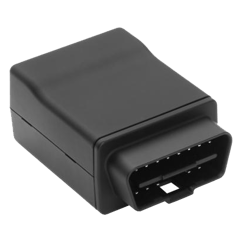GPS tracking devices have evolved from large, heavy devices with multiple microchip motherboards to smaller devices with faster speeds and more functionality. Before you purchase any micro-GPS tracking device, you probably want to know the specifications it offers and its advantages over other pieces being offered in the market.
The GPS market is filled with many tiny GPS devices, most of which are designed specifically for automobile use. It's essential to understand what device works best for your vehicle and tracking needs before you purchase one.
LMU-2600
 The LMU-2600 is a micro-GPS device suited for fleet management. It has a triple-axis accelerometer which measures driver behavior and how that impacts the vehicle. If the driver speeds or is reckless in handling the vehicle, this tracking device records all these mannerism in terms of mileage and speed.
The LMU-2600 is a micro-GPS device suited for fleet management. It has a triple-axis accelerometer which measures driver behavior and how that impacts the vehicle. If the driver speeds or is reckless in handling the vehicle, this tracking device records all these mannerism in terms of mileage and speed.
The LMU-2600 series of GPS trackers offers wireless communication and is inexpensive to install. These devices have a location accuracy of 2m with only 50 channel GPS and works for vehicles with a 12 or 24 volt systems. The general communication mode of the LMU-2600 series includes GPS/GSM/EDGE/HSPA.
LMU-3000
 The LMU-3000 series is a GPS tracking device with high sensitivity GPS for location and tracking. It has an ODB-II (On Board Diagnostic Interface) that accesses your vehicles diagnostic data. The triple-axis accelerometer has motion sensing technology that detects aggressive driver behaviors such as cornering, harsh acceleration and braking. These diagnostics are crucial in tracking your fleet and finding the source of mechanical or electromotive issues that your vehicle endures.
The LMU-3000 series is a GPS tracking device with high sensitivity GPS for location and tracking. It has an ODB-II (On Board Diagnostic Interface) that accesses your vehicles diagnostic data. The triple-axis accelerometer has motion sensing technology that detects aggressive driver behaviors such as cornering, harsh acceleration and braking. These diagnostics are crucial in tracking your fleet and finding the source of mechanical or electromotive issues that your vehicle endures.
You can configure the LMU-3000 series automatically over air firmware, and you can receive updates through PULS. Communication modes for the LMU-3000 series include GPRS/EDGE/HSPA, UDP, CMDA 1xRTT packet data and SMS. This system offers 20,000 buffered messages and supports geofencing technology. These geofencing options have 32-PEG Zones that are restricted to rectangular or circular and 1024 Geo-Zones that are polygons or circles. LMU-3000 has more than 50 channels with a location accuracy of 2m and is AGPS capable.
Similarities and Differences
LMU-2600 and 3000 series have similar location and tracking systems with each containing a triple-axis accelerometer. LMU-3000 offers communication modes that include SMS unlike the 2600 series that is limited to online tracking. The LMU-3000 series is a smaller device that measures 1.5 X 2.5 X 0.98'' (43 x 64 x 25 mm) while the LMU-2600 series devices measure at 2 x 4 x 0.85”, (51 x 102 x 22mm). LMU-2600 is mounted using an adhesive, screw mounting bracket or Velcro while the LMU-3000 is uses either an OBD-II connector or extender cable mounted with self-adhesive. OBD-II connectors are important in reading vehicle data and transmitting it in real time through wireless connection.
Although both devices are fully certified by the FCC, IC, CE, PTCRB, the connection for the LMU-3000 OBD-II interface with a compliant connector while the LMU-2600 series uses a 20-pin Molex fused power harness. Connectors for LMU-2600 have a GPS antenna and a cellular antenna with external SMC. Even on sleep mode you can still transmit data through the LMU-3000 series; which varies greatly from the LMU-2600 that has a physical lithium-ion battery that powers out. Both devices work in extreme temperatures and humidity highly operation on primary power at -35 degrees to 70 degrees Celsius.
The LMU-2600 series is a capable device with a comprehensive input/output system with digital inputs of 200mA and analogue outputs through an internal VCC monitor. LMU-2600 tracking devices have status LEDs and cellular communication.
The LMU-3000 has no output system, but has a Bluetooth 4.0 mode and 2-wire serial port; both of which are optional. LMU-3000 has a built-in GPS antenna for easy installation, pre-impact capturing of data and has 25 geofences while the LMU-2600 has a bigger geofence capability at 32. Both devices are easy to install and configure due to the technology that both of them offer.
Narrowing down your GPS tracking device options means identifying the best fit for your vehicle fleet. It is essential to know the pros and cons of all devices available. You can review performance of these devices by contacting dealers in the same to advice on what tracking device suits your fleet.
Rastrac is a dealer in GPS tracking systems that serve this very purpose. Contact the Rastrac team to learn more about both the LMU-2600 and LMU-3000 series and how you can purchase and install any of these devices.
Like what you're reading? Subscribe to our blog.
Get our latest posts straight to your inbox.
Subscribe to Our Blog





